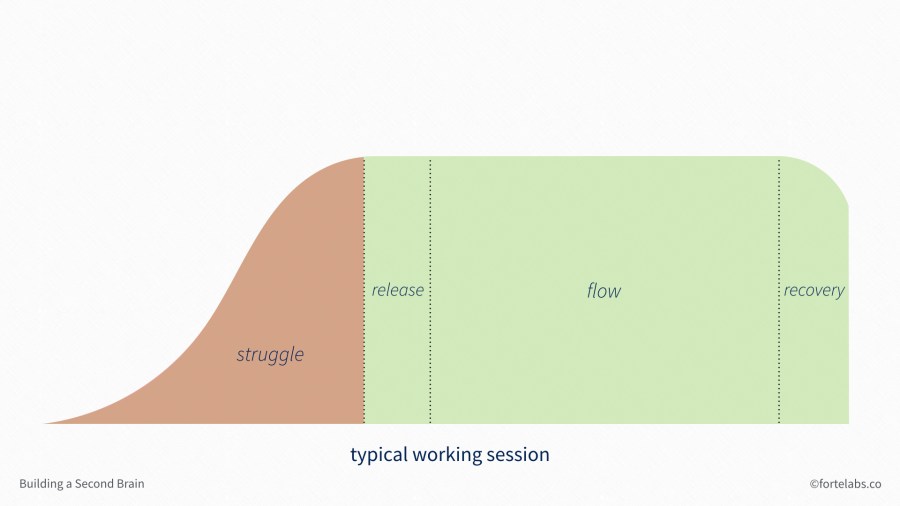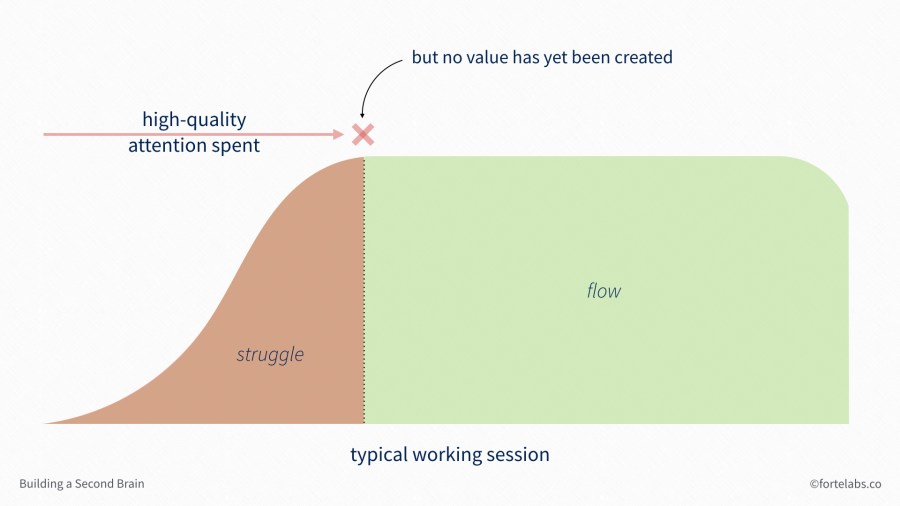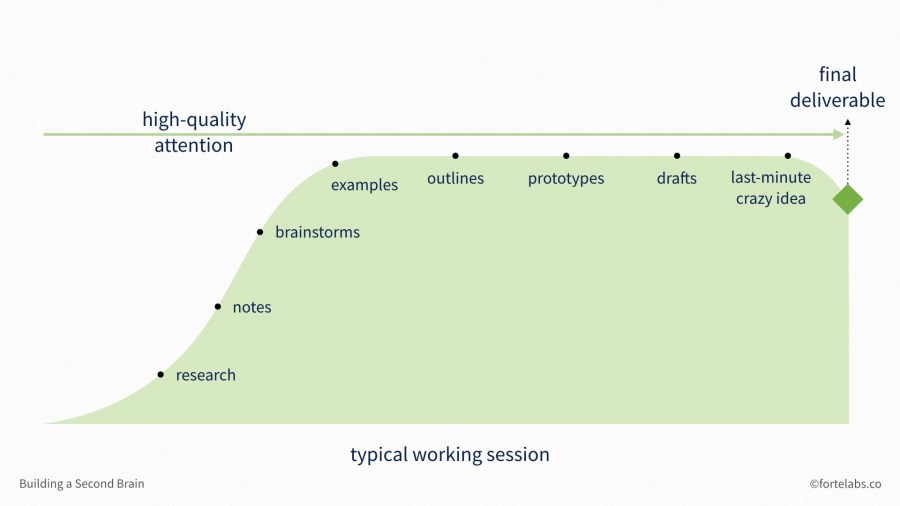
In Part 2, I described the sublime and powerful experience of flow, which could be considered the “holy grail” of productivity.
I argued that there is theoretically no minimum amount of time necessary to get into flow, contrary to popular belief. But in reality, as always, it’s a bit more complicated. Let’s look at what this looks like in a typical working session of a couple hours.
The way work is currently organized and performed, it takes a tremendous investment of resources to get into flow.
First, you have to set up your environment: making your coffee, getting your workspace ready, clearing away desktop clutter, opening the programs you’ll need, and arranging the windows on your computer screen, for example.
Second, you have the mental setup: remembering where you left off, recalling the relevant facts and questions, re-familiarizing yourself with the remaining tasks, and “loading up” many other bits of context.
Third, you have the emotional setup: facing the inner critic, confronting the fear and the doubt over whether you’re working on the right thing, and pushing through the uncertainty that is a part of any challenging task.
This whole ramp-up period is the first of four stages of flow, known as “struggle.”
Sitting down to perform focused work, the body is flooded with cortisol and adrenaline as stress and anxiety rise. The mind and body experience creative risks as if they were physical risks. Taking a creative leap feels a lot like leaping over an actual chasm. The struggle that accompanies any creative or intellectual undertaking is simply unavoidable, regardless of how skilled, confident, or motivated you are.
Our brains evolved this “struggle” stage as a feature, because getting into flow is tremendously expensive.
It’s expensive neurochemically, as the brain burns neurotransmitters much faster than it can produce them. As I explained in A Pattern Recognition Theory of Mind, multiple layers of cortical neurons have to build up their action potentials as they recognize patterns and make connections, which takes energy. It’s expensive in evolutionary terms, as you lose awareness of your surroundings and thus become more vulnerable to threats in the environment. It’s expensive in terms of opportunity cost, as you push aside competing options and dedicate hours to a single pursuit.
The pain of struggle is your brain’s way of asking you, “Are we sure this task is worth getting into flow for?” It is your brain’s way of avoiding unnecessary expenses of time, energy, and attention unless it’s absolutely necessary. You only want to spend these “flow cycles” on pursuits that are truly valuable.
But there’s another, even more important factor that makes getting into flow both risky and expensive. Pushing through the struggle stage takes real time and energy. You have to spend a whole lot of your most precious resource – attention – before you even begin to produce value.
If you set aside that much time, turn down meetings, ignore your email and phone calls for hours, you better have something to show for it. There are intense social pressures to remain available and responsive to others, instead of completing tangible deliverables. So much of the time, we don’t have the confidence that we can produce results that justify the investment needed. It’s so much easier to attend some meetings and fire off some emails instead.
Now consider the best-case scenario: you persevere through struggle and make it into flow. This is practically a heroic act in the modern workplace. You get through Release, Flow, and Recovery successfully, making it to the final deliverable or result you’d intended to produce.
Even then, the problem is that nearly all the value is created at the very end – when you package up what you’ve created for delivery to a colleague, to your boss, or to a customer. As soon as you step away from your desk, all the knowledge you spent so much attention to “load” into your mind – the ideas, priorities, questions, concerns, objectives, problems, potential solutions, examples – promptly gets “unloaded.”
As you step away for lunch, all those potential connections and jumping off points you spent so much attention to acquire just dissolve away. All the intermediate artifacts from that mental labor – the notes, drafts, outlines, files, brainstorms, rough sketches, websites, research, illustrations, screenshots, statistics, mindmaps, diagrams, articles – if we keep them at all, remain disconnected, fragmented, and hidden, scattered across dozens of different apps and folders.
The truth is, you can’t afford to let all that intermediate work go to waste.
Every year you have 261 flow cycles to spend (assuming one per workday, which is generous). What are the chances you will create something unique and valuable if you’re starting from scratch each and every time? How much will you be able to achieve by spending each cycle one at a time, instead of using them to build something that is more than the sum of its parts?
If we consider these flow cycles as our most important asset as knowledge workers, and think about how precious little time we have to make our dent in the universe (or really, just make a decent living), it becomes imperative that we build a knowledge base that appreciates over time.
That is our challenge in building a second brain.
Follow us for updates on Twitter, Facebook, Instagram, LinkedIn, or YouTube.
The Only Subscription
You Need to
Stay at the
Edge of AI
The essential toolkit for those shaping the future
"This might be the best value you
can get from an AI subscription."
- Jay S.
Join 100,000+ leaders, builders, and innovators

Email address
Already have an account? Sign in
What is included in a subscription?
Daily insights from AI pioneers + early access to powerful AI tools













Comments
Don't have an account? Sign up!